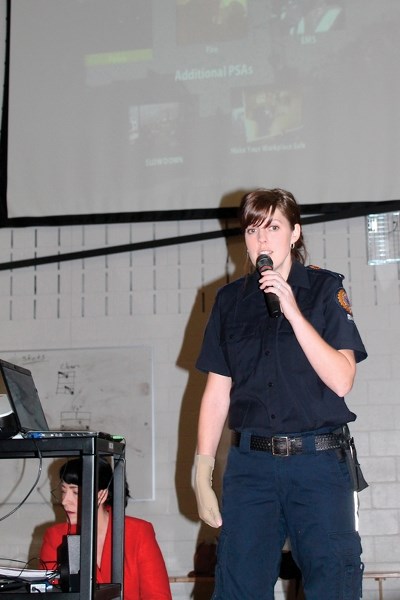They are the kind of demands you'd expect from parents or teachers:Clean up after yourself, tuck your chair in when you're finished at a table, put your clothes, toys and games away.But these were actually the messages shared by an emergency medical technician and a 911 dispatcher during a presentation at Holy Trinity Catholic School on April 3 on how to make homes and schools safer for paramedics, firefighters and police officers when they are responding to an emergency.Jody Laird and Lindsey Jepsen spoke to students at the school on behalf of the John Petropoulos Memorial Fund (JPMF), a Calgary-based charity focused on emergency responder safety.Laird, who is a 911 dispatcher as well as a public speaker, said the presentation centered on the role students can play in “being a hero to everyday heroes.”“By a lot of times doing those simple things that maybe parents have nagged at them about for years and years, the cleaning up after yourselves, making sure that your classrooms and hallways are clear, what are your responsibilities even at home or cleaning up your room, making sure that your stuff is put away,” she said. “All under the pretense that if an emergency responder needs to attend, that essentially you've been a hero to us as well because you're preventing any injuries for us to happen.”Most first responders injured on the job are not hurt because of the emergency situation they're responding to, she added, but because of the environment they have to work in at an emergency scene.Laird shared the story of the JPMF's namesake with the students, telling them how Const. Petropoulos, at the age of 32, fell through a false ceiling while investigating a break-and-enter at a Calgary business in September 2000.Because the business did not have a safety railing in the second-floor area where Petropoulos was walking, Laird told the students, he fell almost three metres into a lunchroom, striking a chair before hitting the floor.He died of brain injuries from the fall.Jepson, an emergency medical technician, said she takes part in the presentations to give people an idea of what emergency responders come across— ranging from poor lighting to cluttered rooms and hallways to inadequate safety signage— on a daily basis on the job.“Whether that's our work environment on the roadways, on which we spend a lot of our time, or in residential houses, schools, buildings, all the different environments that we attend on a regular basis,” she said.The JPMF has shared its message of making spaces safe for emergency responders with businesses and organizations in the past and has just recently started giving the presentations in schools.Jepson said because the school-focused presentations are new, she hasn't seen any results from the talks on the job as of yet.But she added she is encouraged to see students starting conversations about safety whenever she leaves a school following a presentation.“The bottom line is, as an emergency responder, our workplace is everywhere, so the message is relevant everywhere,” Jepson said.Cassidy, a Grade 8 student at the school, said the presentation made her realize she needed to make changes in her life.“I was never really good at safety or anything,” she said. “Me and my friends used to fool around, bike around, BMX with no helmets or anything. Then I realized that, wow, I can actually change everything else.”She added the presentation made a “big difference” to her and her friends and she vowed that she would now wear a helmet, help keep her home clean and tidy and push in her chair when she finishes eating at a table.“I'm definitely going to be aware of all those little things that actually can be big in the future.”Laird said the JPMF has presented at roughly 30 schools so far and the message seems to be sinking in with students.“I think the students are very engaged because our whole energy around it is empowering them to stand up and be leaders within their homes or communities or schools.”She added school staff members are also feeling “supported” by the JPMF's presentation since it helps “increase the buy-in” of messages they're already teaching in the classroom.“If citizens, communities, businesses, schools can take their perspective level of safety to emergency responders, if we can be thinking about keeping our emergency responders safe, then essentially everybody underneath that can be safe as well,” she [email protected]



